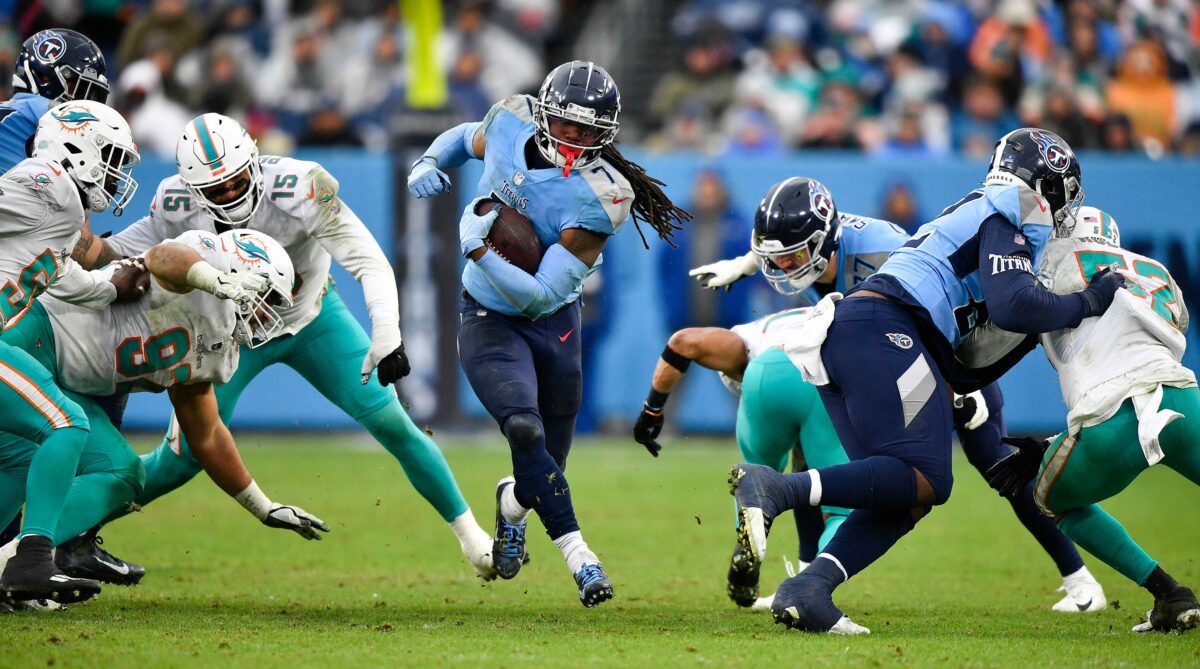The Tennessee Titans ended the Miami Dolphins’ fraudulent win streak on Sunday with a 34-3 victory. It was an impressive win that not only clinched the AFC South, but put the Titans atop the conference.
The Titans’ defense played incredible, but the offense putting up 30-plus points for the first time since they lost Derrick Henry on Halloween was what really stuck out to me.
How did they do it? They did it by returning to their bread and butter, going back to the beginning of the version of the Titans that emerged in 2019 — they traveled back to “The Land of OZ.”
No, that is not Oz, the magical city in the classic “The Wizard of Oz” film. It is O-Z, as in Outside Zone, the play the Titans built their offensive foundation on.
It exploded in 2019, as I mentioned above, but the early genesis can be traced back to Matt Lafleur, who brought over the Zone-Blocking Scheme (ZBS) to Tennessee when he was the offensive coordinator in 2018. Arthur Smith kept the system, and once Ryan Tannehill took over in Week 7 of 2019, it became the Titans’ calling card.
So, what do I mean by “return” and “go back” if it is the foundation of the offense? The answer is found in the playbook of Todd Downing.
While I do not think it was a bad idea, the Titans have gone away from their “OZ” and bootleg attack for much of the season. This was only furthered by the injury to Derrick Henry.
Downing has focused on diversifying the Titans’ offense and that has led to an increase of other run types. The Titans have run more duo, counter, ISO lead and traps than I can ever remember under Smith. I believe this was a deliberate approach. Again, the idea is to diversify a Titans offense that seemed too easy to figure out in previous playoff appearances.
On Sunday, though, the Dolphins’ defensive strategy forced the Titans to go back to old faithful. The Dolphins came out in a 6-1 defense, made popular by Bill Belichick when he deployed it against the Los Angeles Rams in Super Bowl LIII.
As seen in the picture below, the Dolphins stack the defensive line with four guys. They have two linebackers on the edges, creating a six-man front. They will then put a linebacker in the middle and, as Miami often did, brought a safety down in the box next to the middle linebacker to create an eight-man box.

The idea here is to prevent double teams by the line by covering up each player on the line of scrimmage (LOS). The ZBS thrives on LOS double teams, and then linemen climbing to the second level.
Stacking the LOS like this makes it hard to accomplish that, thus eliminating any advantage the ZBS creates. Basically, it forces the O-line into one-on-one matchups without sacrificing the edges or the second level. Guards can’t get up to the second level and linebackers can run free.
This was especially effective against the Titans’ most common play this season, Duo. Duo is a straight run that relies on two double teams upfront, allowing four offensive linemen to move two defensive linemen. After the double teams, two of the O-linemen would climb up to the linebackers, and now you have a well-blocked play.
Again, stacking the LOS with six guys eliminates the ability to do that because instead of two-on-one blocks, every block is one-on-one. With enough guys in the box on defense, it often leaves an unblocked linebacker.
That is exactly what happened early in the game on Sunday. The Titans punted on their first two drives, and it was obvious Downing wasn’t quite ready for what Miami’s plan was. After those two punts, though, Downing adjusted quickly.
The Titans can’t go away from the run because that’s not how they play, but they can go deep into their bag of run plays to do what is best-suited to beat the defense, and in this case, it was a return to the Land of OZ!
As we do each week, let’s step into the film room and see how they did it.
